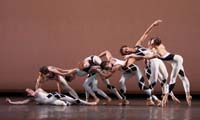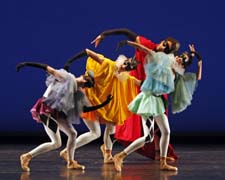
Jack Anderson
Christopher Wheeldon's Second Season
Morphoses/The Wheeldon Company
City Center, West 55th Street between Sixth and Seventh Avenues
October 1-5, 2008 (closed)
Information: (646) 616-1500
Reviewed by Jack Anderson October 7, 2008
 |
Christopher
Wheeldon's "Commedia" at City Center |
Indeed, four of its seven works were not by Wheeldon, the most ambitious of them being Emily Molnar's "Six Fold Illuminate," a ballet to Steve Reich's cheerfully chirruping "Variations for Winds, Strings, and Keyboards" that sent some of its four men and two women moving more or less in place while other people loped in and out. Although Molnar's ingenuity was evident, there was not enough of it to sustain interest throughout the score.
Other works by outside choreographers were miniatures. In Annabelle Lopez Ochoa's "One," Drew Jacoby and Rubinald Pronk twisted speedily about each other to electronic music by Jacob Ter Vedhuis. Despite the contemporary use of classical steps, this duet seemed not all that different in nature from an old-fashioned virtuosic pas de deux.
Genuine imagination enlivened "Shutters Shut," which Lightfoot León (the choreographic team of Paul Lightfoot and Sol León) set to a nonsense text by Gertrude Stein. While the words prattled away about giving orders to Napoleon and shutters shutting, Christine Thomassen and Andreas Heise let their gestures dart forward and back in sharp staccato bursts as if they were engaged in an animated conversation or, given the nutty text, as if they were manically nattering. Words served here as the equivalent of music and verbal and dance rhythms merged.
As danced by Wendy Whelan, Tyler Angle, and Adrian Danchig-Waring, Frederick Ashton's "Monotones II," to Satie, revealed its glorious serenity, the dancers' formations creating constantly expanding and contracting shapes in space. The trio could be termed formally geometric. But this was celestial geometry.
 |
from
left: Leanne Benjamin, Drew Jacoby, Rubinald Pronk, Beatriz Stix
in Brunell in Christopher Wheeldon's "Commedia" at City
Center. Photo by Erin Baiano. |
Wheeldon must love "Monotones II," for much of his "Fools' Paradise" seems inspired by it, since Wheeldon often divides his nine dancers into groups of one woman and two men. Yet there are also duets in this ballet to melancholy music by Joby Talbot and Wheeldon varies his configurations: thus a new woman frequently replaces the previous woman in a trio and a duet couple will sometimes be joined by another couple performing identical or complementary steps. Whereas "Monotones" depicts people remaining in a space yet altering it, "Fools' Paradise" is a ballet of arrivals and departures.
Wheeldon's "Polyphonia," created for the New York City Ballet in 2001, was icily imposing. But his new "Commedia," to Stravinsky's "Pulcinella" suite, was an attempt at freewheeling jollity. Yet I didn't find it all that jolly. Isabel and Ruben Toledo, the designers, made the cast resemble strolling players and their backdrop was filled by enormous carnival masks that threatened to dominate the dancers by their sheer size. The plotless choreography kept an ensemble so perpetually yet monotonously busy that I finally wondered if, divorced from a story or even a hint of dramatic situation, unrelieved merriment can easily turn merely relentless.
Once again, Wheeldon's season was pleasant, but ultimately
unremarkable. Despite his choreographic and directorial urbanity, I still
don't know what he's up to. His repertory, though civilized, lacks any
revelations or provocations that would suggest why it is imperative for
a new company to exist, especially since one can wonder if this is a real
company at all. As it was last year, Morphoses is an aggregation of fine
dancers, some of them stars of well-established companies. What Morphoses
would be like as a permanent organization remains to be seen. Morphoses
is still morphing.
| museums | NYTW mail | recordings | coupons | publications | classified |
